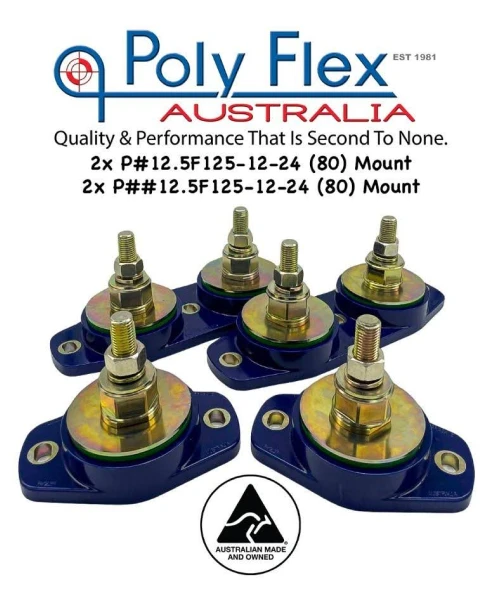A marine engine mount’s primary purpose is to secure an engine to its anchor point while absorbing shocks and vibrations when in operation, making anti-vibration mounting systems essential for preventing damage to the engine and improving performance. Over time, replacement mounts will need to be installed to prevent damage to the engine and to ensure ongoing user comfort. Understanding when your marine mounting systems need replacing is key to having a smooth engine experience. Below, we outline some key symptoms of damaged marine engine mounts and what happens if damaged engine mounts go unchanged, along with a few other frequently asked questions in regard to engine mounting systems. Usually, engine mounting systems tend to last at least years, depending on the application. However, it is always recommended that they be checked regularly when maintenance work is conducted. Making sure your mounting systems are maintained and alignment is obtained will keep your operating experience as smooth as possible.
What happens when commercial engine mounts are not changed regularly?
No matter the quality of your engine mounts, they will begin to wear over time due to the factors above and eventually will require replacement. Not replacing an engine mount that is worn out can lead to the following:
Engine Damage:
Excessive engine movement may occur due to failed marine engine mounts causing misalignment. Damaged or worn mounting systems may cause the engine to slide around in all directions, which can be particularly noticeable when working hard under load.
Risk:
If a marine engine mount breaks under load, it will no longer effectively support the engine. Damaged components can create a safety hazard for yourself and others.
Is there a schedule for replacing marine engine mounts, and should all mounts be replaced at once?
While replacing all mounting systems at once isn’t needed, it is always recommended. When one marine engine mount is damaged, more pressure is put on the remaining, causing them to work harder and accelerate the wear. If you only replace one marine engine mount, it is recommended you pay close attention to the others, as the accelerated wear could cause failure soon after. Therefore, you may have to change more than one mounting system, if not all, depending on how much damage has been caused. As such, it is recommended that all replacement mounts be installed at the same time.
Alignment is key when installing marine engine mounts!
It is important to install the marine engine mounts parallel to the engine’s centreline. The engine bed/bracket must be parallel to both planes (the mounting surface must be parallel with the engine crankshaft centreline). If the marine engine mounts are not installed parallel, they will become “point loaded,” with one end of the engine mounts polymer core compressed and the other unevenly tensioned. This could result in poor performance, a higher potential for stud fracturing, or premature failure.
Hints and tips when installing marine engine mounts.
Height Matters:
It is important the engine bracket isn’t posted too far up the stud. The engine bracket is supported by the adjusting stud. Ideally, the engine bracket should sit as low as possible on the adjusting stud. The higher up the bracket sits on the adjusting stud, the more stressed the stud becomes from the propeller’s thrust risking a break. Over-extending can lead to broken studs or failure due to thrust because the polymer core is deformed. If the brackets end up too high on the stud, shimming is the solution. Shim the engine mount from the bottom using non-compressible materials such as steel, aluminium, fibreglass, or polyurethane.
Support The Engine Mounts Properly:
Engines mounted on weaker stringers can lead to transmission failures. This is due to the most damaging part of the misalignment being taken by the transmission coupling and output shaft bearings. If the marine engine mounts can’t be installed directly on the stringer, it is recommended that heavy-duty brackets that don’t flex be built.
Use The Correct Hardware:
Stainless steel hardware doesn’t have the tensile strength and rigidity needed for most installations when securing the engine mounting systems to the stringer. The ideal fastener is grade eight mild steel to handle the expected loads, and washers should be thick and heavy-duty. All Poly Flex marine engine mounts come ready to install with suitable hardware.
Ensure The Load Is Equal:
Each marine engine mount must carry the appropriate load. Having different loaded engine mounting systems can cause problems with balance, resulting in poor isolation and premature failure. Unevenly loaded marine engine mounts can, in fact, cause more vibration, defeating the purpose of an isolation mounting system. The ideal goal is to balance the weight of the engine/gearbox on each engine mount for the most even distribution.
Ensure The Surface Is Clean:
Mating surfaces for engine mounts should not be painted. Under heavy compression, even a thin layer of paint can cause a loss of tension. Ensure the engine bed is clean of any debris or rust before installing the engine mounting systems. For more detailed information about commercial marine engine mounts, please contact us today.



